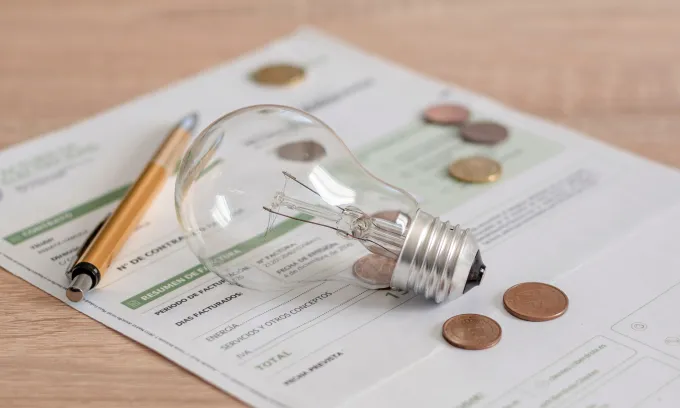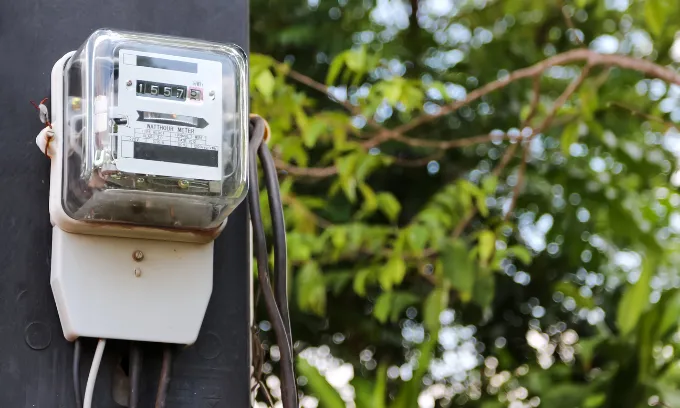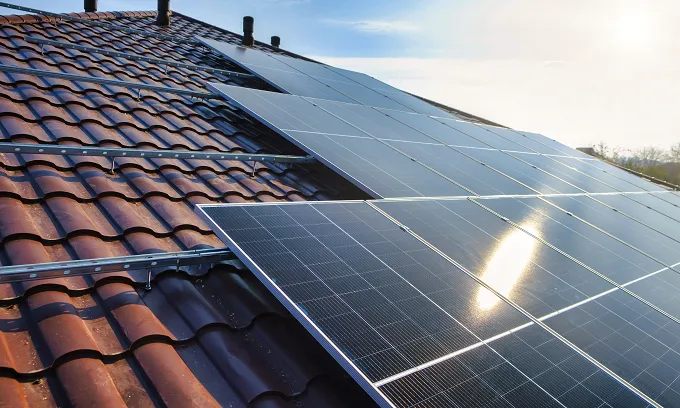How to read an electricity bill
Electricity bills are issued by your energy retailer and detail how much money you owe based on your energy usage costs for the month or quarter, depending on your billing cycle.
As part of the Better Bills Guideline, which came into effect on September 30, 2023, all energy companies are required to show specific details on electricity and gas bills to help consumers understand their usage and costs. These key requirements include simplified language, easy-to-understand design and best-offer messaging.
These improvements are reflected in these sections on your bill:
- Account information
- Electricity cost summary
- Best offer messaging,
- Energy usage summary
- Plan information
- Payment options
- Metering details.
To explain these parts of your bill, we’ll be using a sample bill from Alinta Energy – an electricity and gas retailer that operates across New South Wales, Victoria, South East Queensland, South Australia and Western Australia.
Account information
The first part of your bill summarises all the relevant information about your account. You can see that it includes information such as the issue date for this bill, your account details, your National Meter Identifier (NMI), and how to contact Alinta Energy for customer service, as well as your network distributor for faults and emergencies.
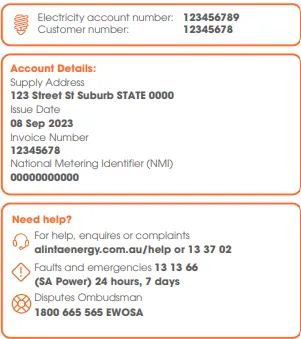
Electricity cost summary
This summarises the total amount owing on your latest bill and the payment due date. The bill in this example is for $47.12, with a due date of September 29, 2023.
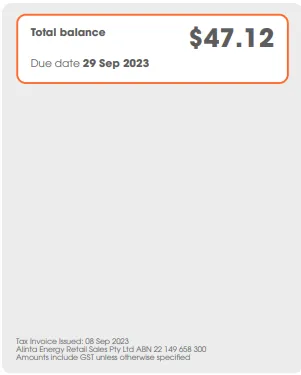
Best offer messaging
This section highlights whether customers could be saving on their energy bill by switching to their retailer’s deemed ‘best offer’.
This is determined using customers’ past usage, typically over 12 months. This information is a legal requirement on bills, enforced by the Australian Energy Regulator (AER) and must also include details on how to switch to this plan.
In the example below, the customer could be saving $157.44 a year by switching from their current offer to Alinta Energy’s best offer for them.
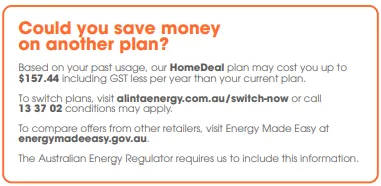
Payment options
This section is usually situated at the footer of the first page of your bill and is fairly self-explanatory.
At the bottom right, you have a recap of what’s owed on this bill.
Above, you’ll be greeted by the payment options you can use to settle your bill, such as direct debit, paying in person at the post office, mailing your payment and paying using a credit card or BPAY by phone or the internet.
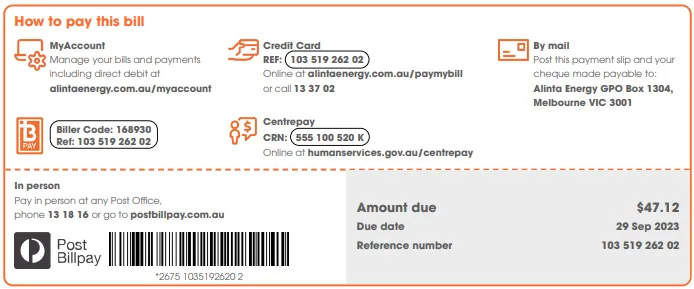
Important information
Also known as ‘Assistance and support services’, this section generally offers information on how to best access the following support schemes:
Payment assistance
The National Energy Retail Law requires all providers to offer payment and support plans for customers facing financial hardship.
Interpreter service
Customers who need translation assistance can access this service via the provided hotline.
National Relay Service (NRS)
The NRS offers hearing and speech-impaired phone support services that interpret what is said or typed.
In this example, this section also includes supporting information on:
- Concession eligibility
- Energy efficiency guide
- How to set up a direct debit
- Tips on connecting electricity to a new home after moving.
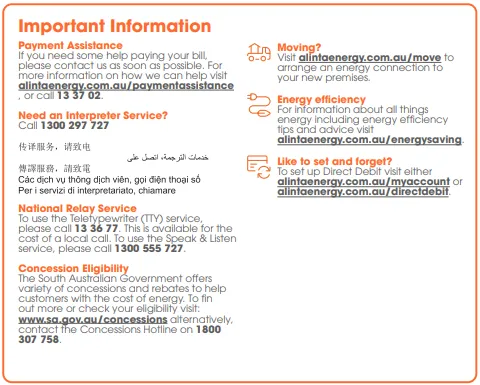
Plan information
In this section, you will find the key details regarding your plan like its name, features and any additional benefits, such as pay-on-time or direct debit discounts.
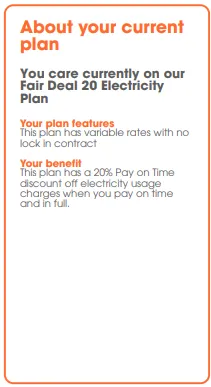
Metering details
This section generally contains the finer details that could help you reduce your energy usage. In this section of your bill, you’ll typically find the following:
Bill credits
The top section displays the credited amount you are entitled to off your bill. Depending on your plan’s terms and conditions, bill credits can be an ongoing or one-off incentive.
Usage charge
The following page shows the type of electricity usage charges. This electricity bill shows that the customer has been charged for peak, off-peak and shoulder rates.
Supply charge
The electricity supply charge, listed below as the 'daily charge' is a daily fixed fee that applies regardless of how much electricity you use.
Read type
This refers to whether your energy usage was read off your meter, or whether it was estimated – in this example, it was listed as 'actual', in other words, read.
Quantity
The total usage recorded from the meter read is used to calculate the final costs of the bill.

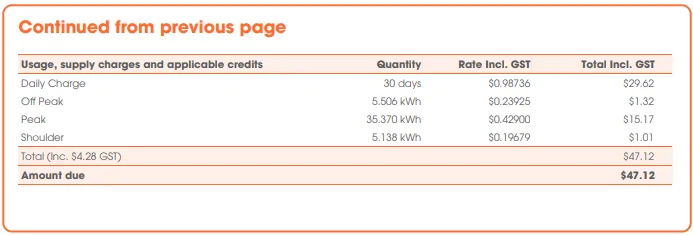
Charging periods
This section offers key insights into how much energy costs at different times of the day, split by each tariff type.
Knowing how electricity is priced at different hours can help you decide if you’re on the most cost-effective tariff or if there’s any room to reduce your energy usage during peak periods.
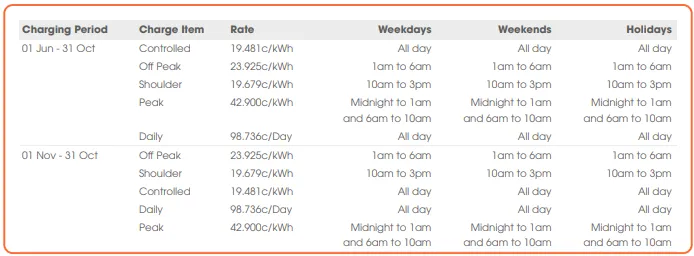
Energy usage summary
This section breaks down your electricity usage, illustrating your energy habits and how your usage compares to homes in your area.
To the left, you can see a graph depicting your total monthly electricity usage and your current daily average usage compared to the same time last year.
On the right, you’ll be able to see your average daily cost, total greenhouse gas emissions and electricity usage compared to other households in your area. This information helps you to visualise patterns or trends in your electricity usage.
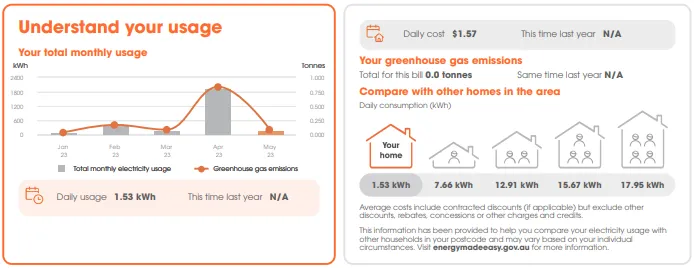
How to read electricity bill's terms
Here is a guide to common phrases found on most energy bills:
Peak hours
The specific times may vary depending on the plan and location. However, peak times are typically Monday to Friday, from 7am to 11am and 5pm to 9pm.
Tariffs
The rate at which you are charged for electricity usually falls into two categories: single rate and time-of-use.
- Single rate: You are charged the same rate throughout the entire day.
- Time-of-use: You are charged different rates based on usage during peak, off-peak and shoulder hours.
Average cost per day
The average daily cost for electricity usage, which includes a daily supply charge.
Average daily usage
The amount of energy you use each day.
kWh
Short for 'kilowatt-hour', this is the unit used to measure your electricity usage.
How can I reduce my electricity bill?
When minimising energy costs, understanding how to read your power bill is only half the battle. Once you analyse the specifics of your electricity bill, it's vital to act on the information you have.
For example, if you discover you don't use much electricity and a large portion of your bill comprises supply charges, you may need to find a better deal suited to low-use households.
Customers on a time-of-use tariff can also use their electricity bill to pinpoint the hours when they’re using the most electricity, helping identify opportunities to reduce their electricity usage.
Your usage information also reveals if your electricity bills are increasing. If they are, think deeply about what could be causing it and whether there are other ways to reduce your energy usage, such as making your home more energy-efficient.
Paying close attention to your plan's electricity rates will also allow you to spot any sneaky price increases from your provider. However, your energy retailer is legally required to inform you of any price increases at least five business days beforehand.



